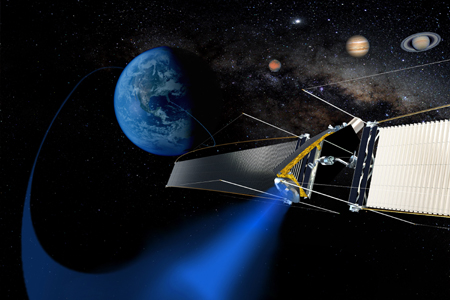HUNTINGTON BEACH, Calif., July 1, 2009 -- An industry team led by The Boeing Company [NYSE: BA] has received a contract from the Defense Advanced Research Projects Agency (DARPA) for work on Phase 2 of the Fast Access Spacecraft Testbed (FAST) program. The $15.5 million cost-plus-fixed-fee contract is currently funded to $13.8 million.
DARPA's FAST program aims to develop a new, ultra-lightweight High Power Generation System (HPGS) that can generate up to 175 kilowatts -- more power than is currently available to the International Space Station. When combined with electric propulsion, FAST will form the foundation for future self-deployed, high-mobility spacecraft to perform ultra-high-power communications, space radar, satellite transfer and servicing missions.
Boeing Phantom Works of Huntington Beach is leading the effort with support from Boeing Network and Space Systems, El Segundo, Calif. The Phase 2 work will include designing, fabricating and integrating test articles, performing a series of component-level evaluations and running two full-scale system tests.
"Our team is pleased to partner with DARPA in developing this powerful new technology," said Tom Kessler, FAST program manager, Boeing Advanced Network and Space Systems. "FAST offers significant cost and performance benefits to our commercial, civil and national security customers, including new high-power applications to provide a cost-effective means for spacecraft to travel to the outer solar system."
During Phase 1 of the program, the Boeing-led team, which includes DR Technologies, Northrop Grumman Astro Aerospace, Texas A&M University, Emcore, Boeing subsidiary Spectrolab Inc., and other key suppliers, developed a preliminary design for an HPGS capable of providing more than 130 watts per kilogram on a system that is less than half the weight and one sixth the size of an existing on-orbit solar power system. The team also defined the test program being conducted in Phase 2, which will verify the performance and operation of the HPGS's solar concentration, power conversion, heat rejection, structure and deployment, and sun pointing and tracking subsystems.
The Boeing team's unique solar concentrator design offers higher performance and greater radiation tolerance than current on-orbit solar power generation systems. Boeing will also be using different approaches to solar cell technology to include capabilities from Emcore and Spectrolab.
The size efficiency of the HPGS enables a new class of compact spacecraft that can self-deploy from low-Earth orbit to reach their final orbit using electric propulsion. This permits the use of smaller, less expensive launch vehicles that can support high-value science missions to the outer solar system without the need for expensive radioisotope power systems.
A unit of The Boeing Company, Boeing Integrated Defense Systems is one of the world's largest space and defense businesses specializing in innovative and capabilities-driven customer solutions, and the world's largest and most versatile manufacturer of military aircraft. Headquartered in St. Louis, Boeing Integrated Defense Systems is a $32 billion business with 70,000 employees worldwide.
# # #
Contact:
Robert Villanueva
Boeing Phantom Works
714-896-2197
robert.s.villanueva@boeing.com
 USA
USA

